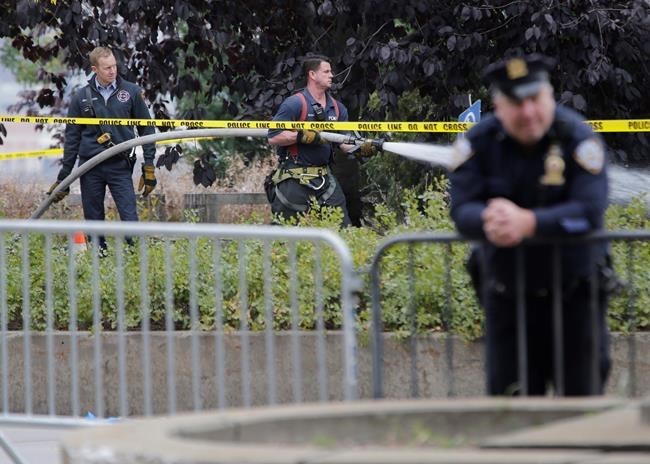
Firefighters spray water over the west side bike path in lower Manhattan, New York, Wednesday, Nov. 1, 2017. Eight people were killed and 12 seriously injured in the Tuesday afternoon attack when, authorities say, Sayfullo Saipov, a 29-year-old from Uzbekistan, barreled along the path in a pickup truck for more than a dozen blocks. (AP Photo/Seth Wenig)
November 01, 2017 - 2:51 PM
NEW YORK - From a Manhattan bike path to Barcelona and beyond, attackers are using vehicles as deadly weapons with growing frequency. Costly security barriers, tougher screening of vehicle renters and sharper intelligence monitoring can help but experts warn that as long as motor vehicles exist, some risks will always remain.
This year alone has seen more than a dozen vehicle-ramming attacks, nearly all in Europe and the U.S., up from the year before. While cars and trucks have been used for violence in the Mideast, attackers in the West are adopting the deadly method.
Some things cities and governments are doing to counter the threat:
THE BASIC BOLLARD — AND HOW TO IMPROVE IT
Whether a post dug into a sidewalk or an unwieldy hunk of concrete, bollards are the most common anti-car shield. Engineers study the ideal height and shape of such barriers to resist damage from various vehicles. Intelligence agencies are increasingly working with manufacturers on optimal bollard design.
One notably ended a rampage in Times Square in May by a driver who ran down 23 people. New York City has installed steel bollards all around town, and some streets near the stock exchange, the 9-11 memorial and police headquarters have retractable barriers that prevent vehicles entering at all.
Because permanent barriers usually need to be anchored deeply, they aren't generally installed on bridges, where two attacks in London occurred this year. Engineers are tackling that challenge with new synthetic materials that can withstand major impact without needing a deep anchor.
Barriers have recently been installed on 33 bridges around London, popular Spanish Mediterranean tourist destinations and the French city of Nice — all as a result of vehicle attacks.
___
ADAPTING THE ENVIRONMENT FOR SAFETY
Cities trying to maintain architectural harmony while increasing safety are using strategically planted trees or making a state-of-the-art bollard look Victorian.
The British soccer club Arsenal's stadium is seen as a model for incorporating "vehicle exclusion" security into its landscape: It's surrounded by giant cannons, concrete benches and huge letters reading ARSENAL that are big enough to stop a vehicle from reaching the crowds.
Train stations are expanding pedestrian zones on their perimeters to further cushion passengers from vehicular threats.
"These sorts of measures can certainly affect the impact" by preventing an attacker from hitting a politically symbolic site or causing mass casualties at a large gathering, said Henry Wilkinson, head of intelligence and analysis at U.K.-based Risk Consultancy Group Ltd.
But he said it's important to make sure the security measures are "proportionate to the threat," and notes there could be significant costs to guard against an attack that may never happen.
Since a truck attack last year in Nice, France, that killed 86 people, the city has launched a $35.3 million ($30-million euro) security effort including waist-high posts connected by steel cables, remote-controlled extendable posts and a citywide sensor system.
Cities can also deploy temporary measures to keep car attacks at bay, like a row of police vans in front of a monument after a threat.
___
UPSTREAM PREVENTION
The driver who targeted a Manhattan bike path Tuesday, as well as the drivers in Nice, London and Barcelona, used rented vehicles in their rampages, prompting calls to crack down on rentals with closer checks of applicant drivers and a codified system for reporting suspicious renters.
"The level of capability required has dropped much lower than it used to be," Wilkinson said. "Ten years ago, terrorist groups were preparing mass shootings and bombing attacks, spectacular attacks, to threaten people. What we're seeing now is that terrorist groups or individuals are less concerned about appearing to have these capabilities."
Experts struggle to say for certain whether New York City could have done more to prevent Tuesday's bloodshed.
"It's very difficult to provide 100 per cent security ... and to keep the balance of putting security in place against maintaining some degree of normalcy," Wilkinson said. "Sometimes the attacks will get through."
News from © The Associated Press, 2017